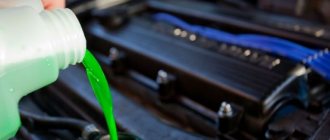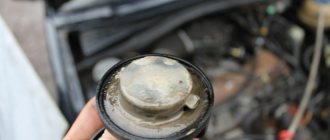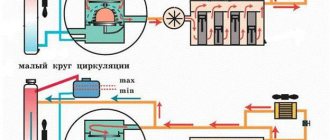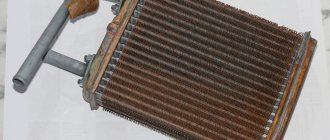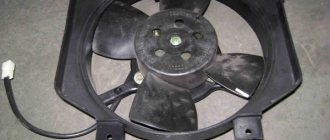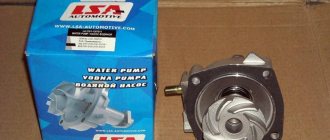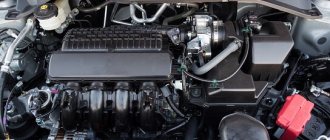One of the main systems of a car engine is the lubrication and cooling system. In normal and working condition, they are closed circuits, so the oil and antifreeze circulating in them do not mix. If the tightness of some elements is broken, oil may enter the coolant. If this happens, it is necessary to urgently determine and eliminate the cause, as well as thoroughly flush the cooling system.
- Cleaning agents
Water - Milk serum
- Fairy
- Powder machine
- Diesel fuel
Video: flushing the cooling system with diesel fuel
Flushing agents
Car owners resort to the following methods as cleaning agents.
Water
You need to prepare distilled or at least boiled water. This option can only be used if the cooling system is slightly contaminated. Water is poured into the radiator, after which the engine is heated to operating temperature and everything is drained. To get rid of the emulsion, you will have to repeat the procedure 5-6 times. This is an ineffective way to flush the system of oil, but it is the most affordable.
Flush the cooling system with water until clear liquid drains out.
Milk serum
You can use whey. Before use, the whey must be strained through cheesecloth to remove any clots and sediment present in it. Craftsmen recommend different periods of time for keeping the whey in the cooling system. Some drive with it for 200–300 km, others fill it up, warm up the engine and drain it.
If after draining the whey there are a lot of clots and oily formations, then it is recommended to repeat the cleaning procedure.
The serum is not very effective in the fight against oily deposits.
Fairy
Use Fairy or similar dishwashing detergent. Pour 200–250 grams of this product into a large amount of water, depending on the degree of contamination of the system, and stir. The engine is warmed up and left for 15–20 minutes.
If after draining there are a lot of impurities in the liquid, then the procedure is repeated. During washing, the detergent begins to foam strongly, so you need to monitor the condition of the expansion tank. This option helps to effectively remove oil from the system, but its disadvantage is the formation of a large amount of foam. It is necessary to rinse the system several times with water until the remaining detergent is removed.
During heating, detergents begin to foam strongly, so you need to monitor the expansion tank
Powder machine
This option is similar to using dishwashing detergent, so it also works well at clearing oil from the system. The advantage is that using an automatic powder produces less foam. When creating a solution, add 1 tablespoon of powder per liter of water.
Diesel fuel
This is the most effective folk method. Fill the system with diesel fuel, warm up the engine and drain the diesel fuel. The procedure is repeated at least twice, and before adding antifreeze, rinse with water.
Some people are afraid that diesel fuel may ignite or damage the pipes. Folk craftsmen claim that nothing like this happens and the method works very effectively. To warm up the engine faster, it is recommended to remove the thermostat while flushing it with diesel fuel.
Video: flushing the cooling system with diesel fuel
Special fluids
You can purchase special liquids for flushing the cooling system in the store. This is the best option for cleaning the cooling system from oil, but it is more expensive than using traditional methods.
Special liquids for flushing the cooling system can be purchased at any auto store.
Each such remedy has instructions according to which you must act. A certain amount of special liquid is poured into the system. Let the engine run for 30–40 minutes and drain, then flush the system with water.
Video: how to flush the cooling system from emulsion
Types of special flushing fluids
There are several types of liquids for flushing the cooling system. According to their chemical composition they are divided into:
- Neutral: do not contain aggressive substances (in particular, alkalis and acids), therefore they are not able to wash away very strong stains; Such compositions are usually used for prevention
- Acidic: liquids based on various acids are excellent for cleaning the system of inorganic compounds
- Alkaline: effectively removes organic contaminants
- Two-component: based on alkalis and acids, so they can be used as universal cleansers
Precautions and washing nuances
When washing yourself, it is best to use special products that are selected depending on the contamination (oil, scale, rust). The use of most traditional methods will not be as effective as the use of special liquids.
Please note that folk remedies are not always cheaper than special ones. In addition, their application takes longer. For example, to clean the system from foam after using dishwashing detergent, you will need to rinse it at least 10 times.
To flush the engine using any means, you must use distilled or boiled water. If you take tap water, scale will form during heating.
There are many ways to flush the cooling system if oil gets into it. Each of them has its own advantages and disadvantages. In order to prevent serious consequences, it is necessary to periodically monitor the condition of the antifreeze and, when the first signs of oil getting into it appear, eliminate the causes and flush the system.
Causes and consequences of oil getting into the cooling system
If you find oil in the expansion tank, try to find out the cause of its appearance as quickly as possible.
Engine fluid may end up in the cooling circuit due to:
- Violations of the tightness between the head and the cylinder block: this happens due to loosening of the fastening bolts, violation of the integrity of the gasket between them, changes in the plane of the head or the appearance of microcracks in the cylinder block
- Leaks in the oil cooler (diesel engines)
When oil gets into the coolant, an emulsion is formed. It clogs the hoses and pipes, so the engine begins to overheat. The emulsion flows very slowly and does not remove heat. It is quite difficult to wash it.
The mixture of oil and antifreeze is highly acidic, which negatively affects plastic and rubber parts (pipes, gaskets, seals). In addition, the emulsion promotes the formation of corrosion on metal elements.
Simply draining the contaminated coolant is not enough, since residual oil from the internal surfaces will again end up in the antifreeze. The cooling system needs to be flushed. This can be done either at a car service center or independently.
Which cleaning method to choose
If you choose how to flush the cooling system from the remaining oil, then the most effective, profitable and safest way is to use flushing liquids. They are specially designed for cleaning and do not contain substances that are aggressive to engine parts and cooling systems. Accordingly, they cannot harm the parts. In terms of cost, buying a flush is often cheaper than folk remedies. The listed special drugs are in the price range from 200 to 600 rubles.
Cleaning with folk remedies does not guarantee a good result. On the Internet on forums you can find many discussions about how folk methods helped some, but not others. Their use may not only not help, but also harm. For example, phosphoric acid contained in carbonated drinks can corrode pipes and seals.
Which way is better?
There are many ways to clean the system with your own hands, but none of them can be considered universal. It all depends on the contamination of the radiator with oil deposits and the material from which the expansion tank and other parts are made.
It is recommended to buy products at car dealerships or special places (for example, service stations). As for traditional methods, when using the same Coca-Cola, you cannot be sure of the quality of cleaning. In addition, if the radiator material is unknown or the person is inexperienced, then you may have to buy a new cooling system, including a thermostat.
For example, many carbonated drinks contain phosphoric acid. It easily corrodes the pipes, and this is an additional expense. It must be taken into account that you should work with any substance carefully, because even if you exclude the risk of damage to car parts, you can get burned yourself.
Experts pay attention to the point that even after cleaning the system with professional means and thorough rinsing, an oil film remains. The radiator is considered cleaned, but it is possible to completely get rid of contaminants and wash out the oil only if the tank is desoldered.
Therefore, despite the purchased preparations and cleaning methods, in case of severe contamination it is often advised to prepare for a complete replacement of all parts of the system. Only timely repairs and car care will keep your vehicle in good condition.
Determining the degree of blockage
There are several ways to determine the degree of CO contamination:
- Engine inspection. Its overheating may be due to various reasons, but lack of cooling of the power unit is one of the main ones. If the engine constantly overheats, you need to diagnose the cooling system.
- Checking the expansion tank. The degree of clogging can be determined by the presence of sediment in the tank. But to do this, the container will have to be dismantled. It is unlikely that it will be possible to determine the presence of deposits on a reservoir installed under the hood. You can try shining a flashlight on the container. If a layer of sediment is visible at the bottom, then it’s time to rinse the CO.
- Monitoring the condition of the coolant. The presence of rust and traces of scale in the coolant indicates the need to replace the refrigerant and clean the CO.
- Inspection of hoses. Clogged pipes can be determined by disconnecting one of the hoses. Be careful as refrigerant will begin to escape from the line when disconnected. If you see that blockages inside the pipe are preventing consumables from passing through the system correctly, you should flush it.
User VChSLV published a video about cleaning and replacing the refrigerant.
Application of citric acid
Experienced car owners are well aware of the fact that the basis of all such cooling system cleaning products is citric acid. Why pay several thousand rubles and buy such cleaning liquids, if you can literally buy a small amount of lemon juice in the nearest store for 100 rubles and use it to clean the entire cooling system. The direct use of such improvised folk remedies is not particularly difficult, which allows you to significantly save on the operation of the car, and anyone, even a novice car owner, can carry out the necessary service.
If there is noticeable overheating in the car, the engine begins to run unevenly, then it is quite possible that it is time to clean the cooling system. The easiest way to do this work is on an overpass or in a garage pit, which will allow you to easily drain the old antifreeze. All you need is a small amount of citric acid and distilled water. It is necessary to add lemon juice to distilled water at the rate of 100 grams of chemical per 10 liters of water. The solution is thoroughly mixed and poured into the cooling system with drained antifreeze.
All that remains is to start the engine, warm up the engine to 90 degrees, this will allow all the liquid to be distributed throughout the system, then turn off the engine and leave the car for several hours. During this time, citric acid dissolves existing dense deposits, after which the liquid is drained, which after this procedure may have a rusty or black color.
The car owner will only have to pour new antifreeze into the system and bleed the pipes to get rid of air jams. The engine is started, checking the performance of the entire system, the engine must be properly cooled, and antifreeze must circulate first through the small and then through the large circuit. By doing this work yourself, you can solve all problems with the functioning of the cooling system for two to three years, and the engine will work correctly. At the same time, the car owner will avoid problems with engine overheating and possible serious breakdowns only due to the operation of the power unit at high temperatures.
ICE cleaning options
Today, car power units are cleaned of old grease in various ways.
Five minute rinse
This product is poured into the engine immediately before changing the engine oil, mixed with the “working off”. After this, the internal combustion engine is started, idling for 5-10 minutes. This is followed by the traditional draining of the used composition, changing the filter and injecting new lubricant.
Flushing oil
Here, a specialized motor lubricant is used, which is poured in after removing the used composition. The engine runs for some time with this oil at idle speed, after which the substance is changed to fresh motor oil and the filter is cleaned.
Flushings with which they travel
This option allows you to travel a certain distance with the cleaning agent. A special substance is added to the old lubricant about a hundred kilometers before the next oil change, and until that moment I operate the car correctly and carefully. When it comes time for maintenance, the engine oil is changed according to the standard procedure.
Extra grease
This option is recommended for use when changing the lubricant to a composition with a different base, or for flushing very dirty engines. First, you should drain the used lubricant and pour in the composition that will be used in the subsequent operation of the car.
The amount of fresh oil can reach only a couple of liters. The engine idles for a short time. After this, all the lubricant is changed back to fresh, and a new filter is installed.
How to clean the tank?
How to clean the inside of the expansion tank from rust? Maybe someone has experience, tell me what kind of remedy.
PS: The tank was removed from the car.
Comments 30
WARNING: CAUSTIC SODA REACTS WITH ALUMINUM. If the radiators and other parts are aluminum, then they will be damaged.
rust in the expansion tank... tin...
It’s a shame only for those who haven’t gotten into their cooling system yet.
yes, I climbed somehow. tore off the pipe from the heater radiator, changed the expansion pipe with a cap, changed the antifreeze, clean and red and no rye
So you got the car from a good owner, unlike me, I got it from a collective farmer.
I got it from a very shitty owner, it’s just that his crooked hands didn’t reach the cooling system)
It’s a shame only for those who haven’t gotten into their cooling system yet.
In general, antifreezes have lubricating and anti-corrosion properties. Apparently you once had water in the cooling system, I would advise flushing it completely, because... excess deposits can clog it, and this already threatens with much more serious consequences than cleaning the expansion valve
try ADRILAN, there is such a household chemical product that contains caustic soda. work in rubber gloves, otherwise the skin will peel off. Sold in a pink plastic bottle.
I removed it and cleaned it with white spirit from oil and rust... you can also use Sanox
